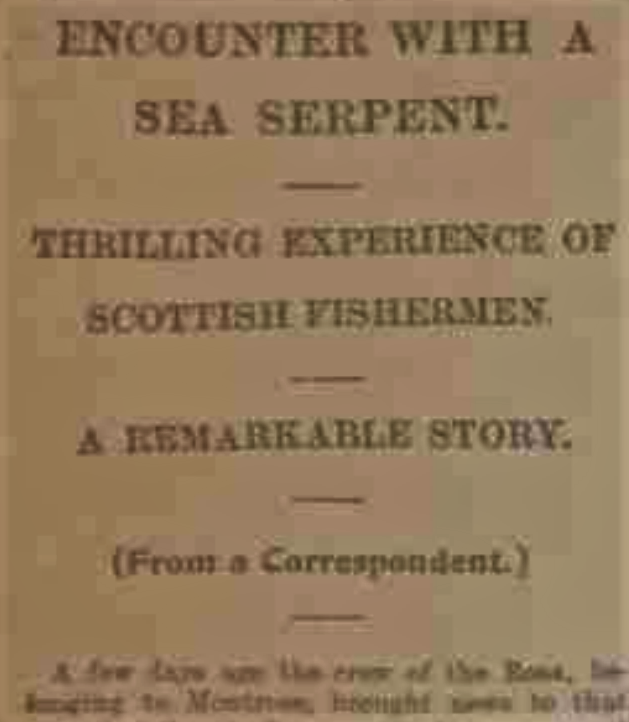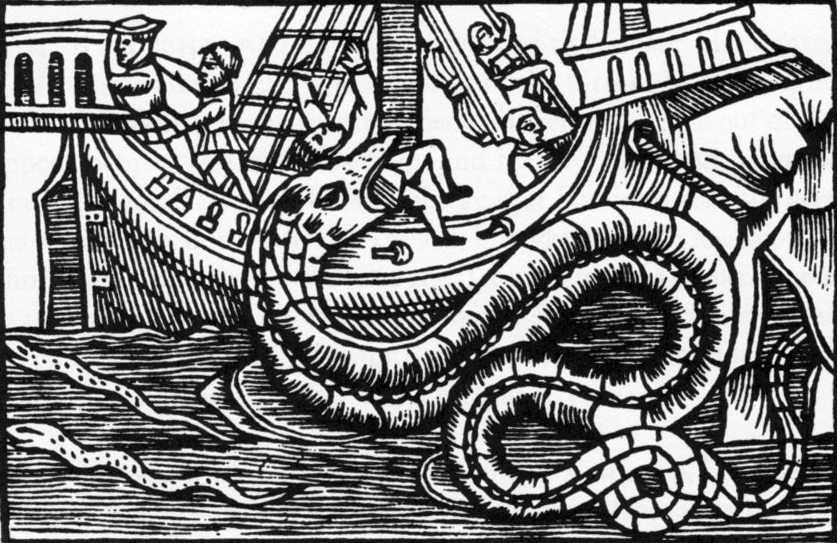Fishermen are known for their tall tales, but few are as tall as the tale told of the gigantic fire breathing sea serpent that attacked a Scottish trawler in 1903. Reports of sea monsters were fairly common in the newspapers of the nineteenth and early twentieth centuries, but the desperate battle between the crew of the Glen Grant and the North Sea Monster is one of the most exciting.[i] The account below is based on supposed eyewitness accounts described in the British press.
In the early hours of Tuesday 8 September, the steam trawler Glen Grant was heading away from Fraserburgh, Aberdeenshire towards its fishing grounds. In charge of the vessel and the nine man crew was Captain Joseph Carter, described as an ‘old and tried seaman’.
An Enormous Monster with a Head Like a Chinese Dragon
At 5am, those on deck became aware of a roaring sound accompanied by a seething turmoil in the water. It was assumed that this was caused by whales, but the crew looked on in disbelief as ‘an enormous monster with a head like a Chinese dragon’ rose up from the sea.
The size of the monster was estimated to be around 200 feet – twice as long as a blue whale, with an improbably long 50 foot neck standing up out of the water. The serpent was described as dark in colour with a head like a sea horse (or a Chinese dragon in some reports) and with a long fin or mane running down the back of its neck. Its eyes burned with a terrifying green fire and glistening teeth were visible in its cavernous mouth. Around the mouth were great tusks and whiskers that ‘stood out like topsail yards’.
The strange creature ploughed through the waves towards the Glen Grant with a strange swaying motion and most of the terrified crew scrambled to various hiding places. The monster then ‘rested his chin reflectively on the truck of the mainmast’ while the few crew that remained on deck watched unable to move.
Fiery Breath
The creature’s attention was caught by the open skylight of the cabin, and he thrust his head through the opening. Inside, Captain Carter, the ship’s mate and the steward were about to take their morning coffee when ‘the awful looking head swung across the table’. The Captain and the mate, being strict teetotallers, knew this was not a hallucination and dropped their coffee mugs and fled. The unfortunate steward, though, found himself cornered and unable to make his escape.
The monster slowly inspected the inside of the cabin before scorching the steward’s whiskers and the cabin’s paintwork with his fiery breath. The creature then removed his head from the cabin.
Back on deck, one of the crew hurled a belaying pin (a metal rod used in ship’s rigging) at the monster. The noise it made when it hit the creature ‘sounded as if an iron tank had been struck’. The monster then disappeared into the sea with a strange hissing sound.

Lifted by Some Giant Hand
Their ordeal wasn’t over. The serpent dived under the Glen Grant and the vessel found itself lifted out of the sea as if by a ‘giant hand’. They hung in the air for a few seconds with the waves foaming below them before being plunged down with such force that everything on deck was swept away and the cabin and engine room were flooded.
The horrified crew watched as the monster swam some distance away from the Glen Grant. Then, to the crew’s utter consternation, it turned and began to head back towards the trawler at a furious speed ‘as if he was resolved to crush the ship to pulp’.
At this point, one of the crew – a fisherman called Wiseman – dashed to retrieve his gun from below deck. When the monster was about 15 yards away he aimed and fired. It’s not clear if the shot was accurate, but in any case the monster hesitated before diving beneath the waves showing a ‘long sinuous body’. They watched the creature through their glasses as it undulated under the water, but it did not attack again.
It took the crew some time to recover their senses after the sensational events, though they eventually turned to pumping out the ship and pulling in their nets before steaming back to shore. The Captain, we are told, was reluctant to come forward with his testimony but was persuaded to do so by his crew, who were all natives of Aberdeenshire.
How Long is a Sailor’s Yarn?
So how plausible is this 200 foot long, green-eyed, dragon-headed, lion-maned sharp-toothed, whiskery fire-breathing sea monster? Well, although the account was widely reported in 1903, the press treated the story with tongue-in-cheek sarcasm. Many pointed out that tales of mysterious sea serpents cropped up every year and treated this report as an unlikely but thrilling yarn. The monster’s size – twice as big as the world’s largest animal, the blue whale – is certainly implausible, and fire-breathing is an unlikely superpower for an underwater creature.
However, the Glen Grant was a real trawler. Furthermore, the crew of another steam trawler, the Montrose, had reported a much less dramatic encounter with a sea serpent off the eastern Scottish coast a few days before. This creature was estimated at over 100 feet long and raised its head 5 or 6 feet above the water. It moved in a ‘snaky’ fashion and ‘humps’ also protruded from the waves in stereotypical Nessie style, though no other details were given, and there were certainly none of the fantastic elements attributed to the much more impressive monster that supposedly attacked the Glen Grant.[ii] The Montrose sighting is consistent with a misperceived whale, perhaps, but was widely reported as being the same creature that attacked the Glen Grant.
So what happened to the crew of the Glen Grant? Did they have an ambiguous encounter similar to the men on the Montrose and then decide to add some colourful details? Or were the exciting events invented by sensation hungry journalists hoping to fill in some column inches? Were the whole crew of the Glen Grant in on a monster hoax? Or is there really a fire-breathing monster – the biggest on earth – inhabiting the North Sea?
Some of the improbable details – the size, the fire-breathing, the metallic clang the monster made when hit with the belaying pin, the way it rested its chin ‘reflectively’ on the ship – makes me feel someone is pulling our leg, but if hoax it is, it’s a delightful one and deserves to better known. It would make a great monster movie.
But this wasn’t the last time that a monster from the deep visited our shores. Stay tuned for the story of Slippery Sam – the Yorkshire Sea Monster….
[i] Dundee Courier, 12 September 1903; Westminster Gazette, 14 September 1903; Derry Journal, 16 September 1903; Northern Scot and Moray and Nairn Express, 19 September 1903
[ii] Dundee Courier, 7 September 1903; Montrose, Arbroath and Brechin Review, 11 September 1903
